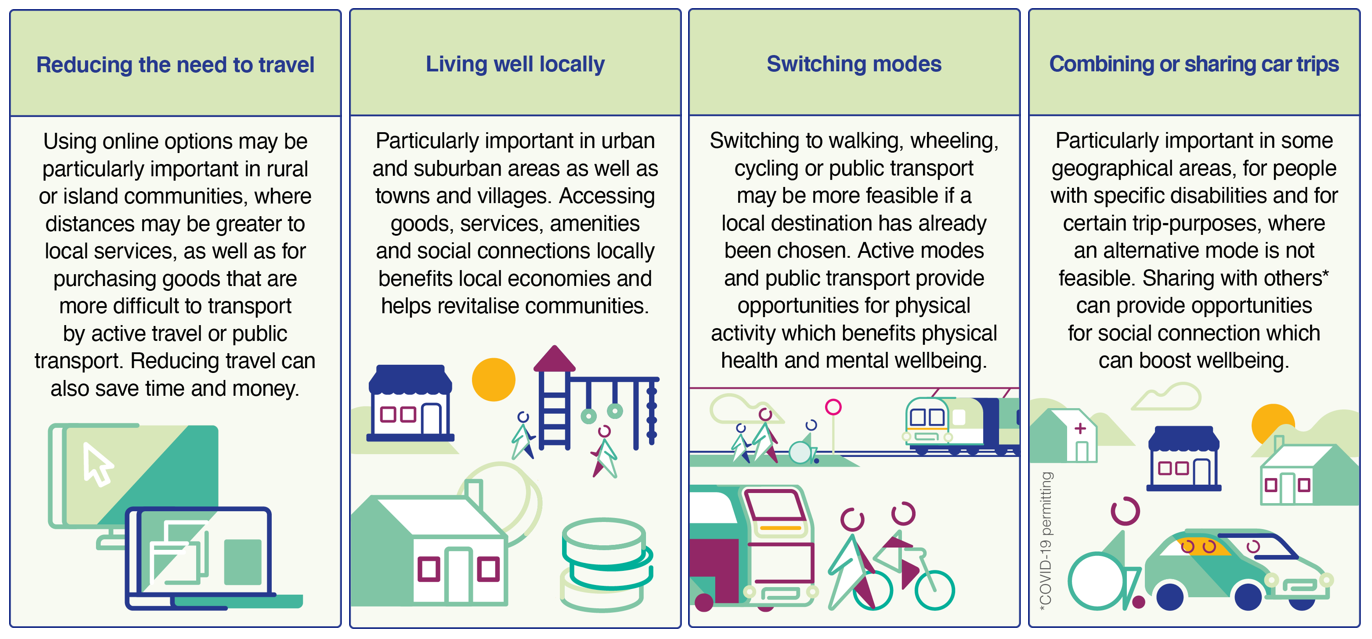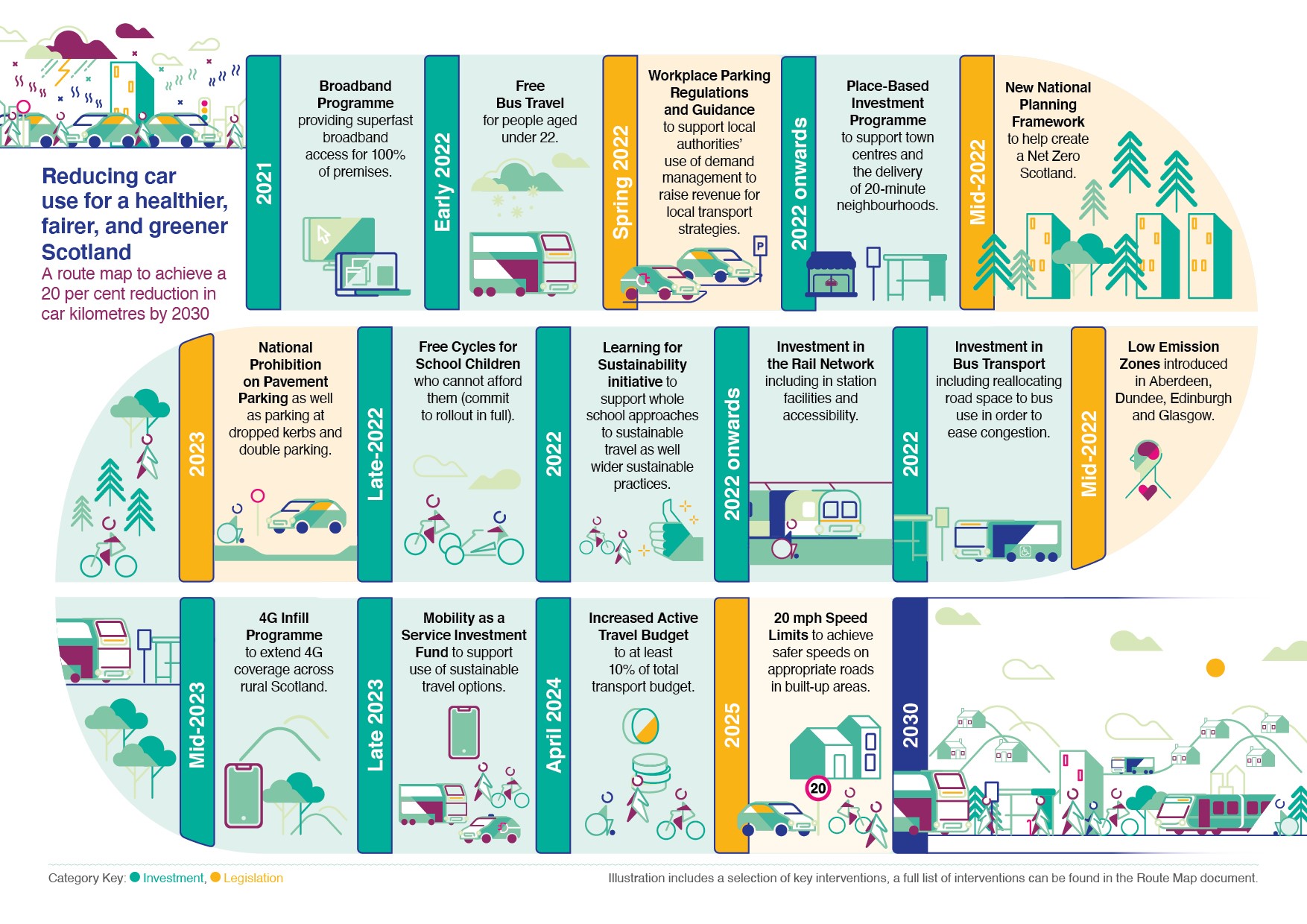Executive summary
Our Target
In response to the global climate emergency, Scotland’s Climate Change Plan update in 2020 set out a world-leading commitment to reduce car kilometres by 20 per cent by 2030. Transport accounts for 29 per cent of Scotland’s greenhouse gas emissions, with cars making up 38 per cent of those transport emissions. Carbon-reduction modelling has concluded that it will not be possible to reach net zero emissions through technological solutions alone. Reducing car use is essential in order for the transport system to be decarbonised at a pace that meets the statutory emissions targets set by the Scottish Parliament.
Wider Benefits
Reducing the dominance of private cars offers significant benefits both to individuals and wider society, including improved health and wellbeing, reduced inequalities and more inclusive economic prosperity. Reducing car use will also improve our public places, making them more attractive, safer and healthier spaces in which to live, work and spend leisure time.
Opportunities for Change
Scotland’s hosting of the 2021 United Nations Climate Change Conference (COP26) has led to increased public awareness of the need to tackle climate change. Over 90 per cent of Climate Assembly members, selected to be representative of the Scottish population, agreed that Scottish Government needs to ‘support the transition from car use to public and active travel’, and over 60 per cent supported a recommendation to ‘phase in increased road taxes for private car use and use the revenue to subsidise public transport’.
Cars currently make up over 75 per cent of total traffic volumes on our roads and the majority of all journeys in Scotland are made by car. We recognise that some private car use will need continue, especially for people in certain geographical areas and those with certain disabilities. However a significant proportion of existing car journeys have the potential to be made in other ways. A recent public opinion survey found around 50 per cent of respondents agreed it would be possible not to use their car for common trip types. Furthermore, around 30 per cent of households in Scotland and 60 per cent of households on the lowest incomes do not have access to a car. We must take further action to enable more people to safely access goods, services, amenities and social connections, without the need for private cars.
Our Actions
We are committed to taking action across the full range of Scottish Government policy areas that will enable individuals and organisations to choose healthier, fairer and more sustainable travel options. This document has been developed by the Scottish Government and the Convention of Scottish Local Authorities (COSLA). It recognises the need for ongoing collaboration and partnership working between national, regional and local government as well as groups and organisations across Scottish society in order to deliver a national shift in travel behaviours, without stipulating a uniform 20 per cent kilometre reduction in all geographical areas. We will also seek to work with the UK Government on reserved matters, such as the successors to motoring taxation, which we believe has a key role to play in reducing car use going forward.
We have developed a framework of sustainable travel behaviours that is applicable in both rural and urban settings as well as for those with a variety of mobility needs. These are: reducing the need to travel, such as by using online options to access goods, services, amenities and social connections, if these cannot be accessed locally in a sustainable way; living well locally, by choosing local destinations which can make it easier to switch to more sustainable modes and will reduce distances driven if a car is still used; switching modes to walk, wheel, cycle or public transport where feasible; and combining trips or sharing journeys with another person (in line with prevailing public health guidance) if car use remains the only feasible option. The aim is to empower people to choose an option that fits their circumstances and travel needs.
Our route map sets out the actions we will take between now and 2030 to support each of these four behaviours. In the near-term these are predominantly actions to encourage alternative behaviours. We are, however, committed to exploring options to further discourage car use, including developing a Car Demand Management Framework, based on further research into equitable options to discourage car use, by 2025.
Illustration
The following graphic illustrates the four desired behaviours in reducing car use:
Reduce the need to travel - The text reads: 'using online options may be particularly important in rural or island communities, where distances may be greater to local services, as well as for purchasing goods that are more difficult to transport by active travel or public transport. Reducing travel can also save time and money.'
Live well locally - The text reads: 'particularly important in urban and suburban areas as well as towns and villages. Accessing goods, services, amenities and social connections locally benefits local economies and helps revitalise communities.'
Switching modes - The text reads: 'switching to walking, wheeling, cycling or public transport may be more feasible if a local destination has already been chosen. Active modes and public transport provide opportunities for physical activity which benefits physical health and mental wellbeing.'
Combine or share car trips - The text reads: 'particularly important in some geographical areas, for people with specific disabilities and for certain trip-purposes, where an alternative mode is not feasible. Sharing with others - COVID-19 permitting - can provide opportunities for social connection which can boost wellbeing.'

The following S-shaped illustration includes a list of year-by-year selected investment and legislative interventions which comprise a 'journey' to reducing car kilometres by 2030. Full details of each intervention are provided in text format in section 3.
